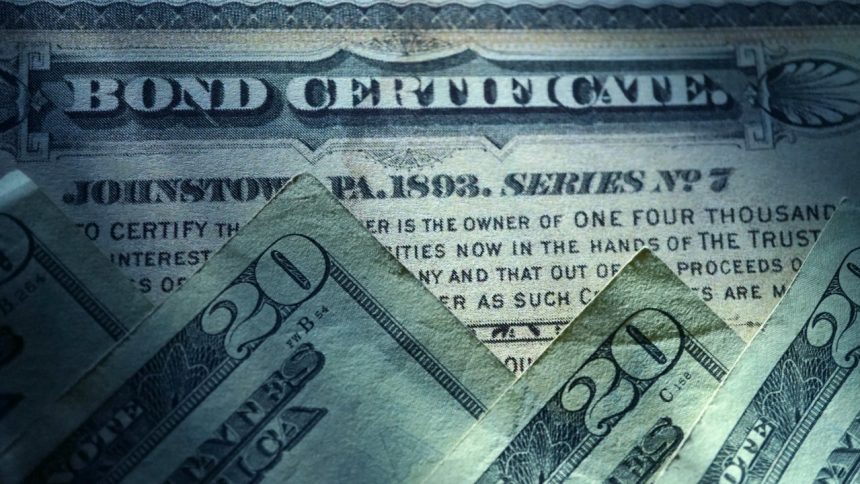Corporate bonds are one way to invest in a company, potentially offering a lower-risk, lower-return way to bet on a business’s ongoing success compared to its stock. Bonds offer a regular cash payout, and their price tends to fluctuate less than a company’s stock. For investors wanting a higher return than might be available on a CD with a little more risk, bonds make a compelling option.
Here’s what a corporate bond is and the risks and rewards for investors in them.
What is a corporate bond?
A bond is one way to finance an organization, and it’s an agreement where a borrower (the bond issuer) agrees to pay a certain amount of interest to a lender over a specific time period in exchange for lending a sum of money, the principal. When the bond matures at the end of the period, the borrower repays the bond’s principal, and the agreement is concluded.
A corporate bond is a bond issued by a company, often a publicly traded company. It stands in distinction to bonds issued by other organizations, such as Treasury bonds issued by the U.S. federal government and municipal bonds issued by state and local governments.
How interest payments work on corporate bonds
The interest payments on bonds come in two major types: fixed rate and floating rate. With a fixed-rate bond, the interest is paid according to an exact agreed-upon rate, and that’s all the payment the investor will receive. With a floating-rate bond, the payment can fluctuate higher or lower, often according to the prevailing interest rate environment.
A bond typically pays interest on a regular schedule, usually semi-annually, though sometimes quarterly or even annually. A bond’s payment is called a coupon, and the coupon will not change except as detailed at the outset in the terms of the bond. A fixed-rate bond might offer a 4 percent coupon, for example, meaning it will pay $40 annually for every $1,000 in face value.
The face (or par) value of a corporate bond is typically $1,000. That’s usually the minimum to buy a bond, though you can buy a diversified bond portfolio for much less using bond ETFs.
If the corporation is unable to make its interest payments on a bond, the company is in default. A bond default could trigger the company into ultimately declaring bankruptcy, and the investor may be left with nothing from the bond investment, depending on the company’s indebtedness. However, bond investors are paid before shareholders in the event of a bankruptcy.
How bonds are rated
But before you worry about the borrower defaulting, know that bonds are rated on the quality of their issuer. The higher the issuer’s quality, the lower the interest rate the issuer will have to pay, all else equal. That is, investors demand a higher return from corporations or governments that they view as riskier.
Bonds broadly fall into two large categories based on their rating:
- Investment-grade bonds: Investment-grade bonds are viewed as good to excellent credit risks with a low risk of default. Top companies may enjoy having investment-grade credit ratings and pay lower interest rates because of it.
- High-yield bonds: High-yield bonds are also referred to as “junk bonds,” and they are viewed as more risky, though not necessarily very high risk, depending on exactly the grade and financial situation. Plenty of well-known companies are classified as high-yield while continuing to reliably make their interest payments.
Bonds are rated in the U.S. by three major ratings agencies: Standard & Poor’s, Moody’s and Fitch. The highest-quality bonds are rated Aaa at Moody’s and AAA at S&P and Fitch, with the scales declining from there. Moody’s ratings of Baa3 and BBB at S&P and Fitch are considered the lowest investment-grade ratings. Ratings below this are considered high-yield or junk.
What are the risks and rewards of corporate bonds?
Corporate bonds offer many risks and rewards. Investors looking to buy individual bonds should understand the advantages and disadvantages of bonds relative to other alternatives.
Advantages of corporate bonds
- Regular cash payment. Bonds make regular cash payments, an advantage not always offered by stocks. That payment provides a high certainty of income.
- Less volatile price. Bonds tend to be much less volatile than stocks and move in response to a number of factors such as interest rates (more below).
- Less risky than stocks. Bonds are less risky than stocks, and are among the best low-risk investments. For a bond investment to succeed, the company basically just needs to survive and pay its debt, while a successful stock investment needs the company to not only survive but thrive.
- May yield more than government bonds. Corporate bonds tend to pay out more than equivalently rated government bonds. For example, corporate rates are generally higher than rates for the U.S. government, which is considered as safe as they come, though corporate rates are not higher than all government bond rates.
- Access to a secondary market. Investors can sell bonds into the bond market, giving them a place to achieve liquidity for their holdings, an advantage not offered by bank CDs.
Disadvantages of corporate bonds
- Fixed payment. A bond’s interest rate is set when the bond is issued, and that’s all you’re going to get. If it’s a fixed-rate bond, you’ll know all the future payments. If it’s a floating-rate bond, the payments can fluctuate, but you’ll know the terms. This stands in contrast to dividend stocks, which can raise their payouts over time for decades.
- May be riskier than government debt. One reason corporate bonds yield more than safe government bonds is because they’re riskier. In contrast, a government can raise taxes or issue its own currency to repay the debt if it absolutely has to.
- Low chance of capital appreciation. Bonds have a low chance of capital appreciation. What you should expect to earn on a bond is its yield to maturity. In contrast, a stock could continue to rise for decades, earning much more than a bond could.
- Price fluctuations (unlike CDs). While bond prices generally fluctuate less than stocks, they still do fluctuate, unlike CDs. So if you need to sell a bond for some reason at any point, there’s no guarantee that you’ll receive all your money back.
- Not insured (unlike CDs). Bonds are not insured, unlike CDs backed by the FDIC. So you can lose principal on your bonds, and the company could default entirely on the bond, leaving you with nothing.
- Bonds need analysis. Investors buying individual bonds must analyze the company’s ability to repay the bond. So, investing here requires some work.
- Exposed to rising interest rates. Bond prices fall when interest rates rise, and investors often don’t have the advantage of a rising payout stream to compensate them.
While that may seem like a lot of risks, the U.S. bond market remains a popular place for big money managers to park their money and receive a return. However, bonds usually offer limited upside in exchange for substantial downside, so you want to be sure to know the risks.
How to buy a bond
When a company first issues a bond, it’s usually purchased by an institutional investor or another investor with a lot of money. This large investor can then sell the bond at any time in the public bond market, which is where individual investors and others can purchase the bond.
It can be easy to buy a bond, and major brokers such as Interactive Brokers, Fidelity Investments and Charles Schwab make it easy to buy individual corporate bonds. You’ll just need to input the issuer and select the bond maturity you’re looking for, since many companies offer more than one series of bond.
On the market, bond prices can fluctuate. Bonds that go above their issue price are called premium bonds, while those that fall below it are called discount bonds. Bond prices can fluctuate for a number of reasons, including:
- A decline in the issuer’s rating: If a ratings firm downgrades a company, its bonds may lose value.
- The company’s business declines: If investors think a company may have trouble paying its debts due to a slumping business, they may push its bond prices lower.
- Interest rate moves: The price of existing bonds will rise or fall inversely to the direction of interest rates. If rates rise, the price of bonds will fall. Meanwhile, if rates fall, the price of bonds will rise, as you can see in the chart.
Because a bond’s price fluctuates — changing its yield — you’ll want to look at the bond’s yield to maturity to see what return it could offer you. Premium bonds will offer a yield to maturity that’s less than the stated coupon, while discount bonds will offer a yield that’s higher than the coupon.
Why you might like bond ETFs instead of bonds
Bond ETFs can be a great way to buy corporate bonds instead of selecting individual issues. With a bond ETF, you’ll be able to buy a diversified selection of bonds and can tailor your purchase to the type of bonds you want — and you can do it all in one fund.
Here are some of the advantages of bond ETFs:
- Diversification: Corporate bonds come in a wide variety of types, depending on maturity (short, medium and long) and rating quality (investment-grade or high-yield). A bond ETF allows you to buy bonds from many companies in one fund, reducing your risk.
- Less analytical work: If you’re buying a bond ETF, you don’t need to analyze the company as you would for individual corporate bonds. You can buy the type of bonds you want, and the fund’s diversification helps reduce your risk.
- Lower minimum investment: A typical bond has a face value of $1,000, but with a bond ETF you can buy a collection of bonds for the price of one share — which may cost as little as $10 — or even less if you’re working with a broker that allows fractional shares.
- Cheaper than buying individual bonds: The bond market is usually less liquid than the stock market, with wider bid-ask spreads costing investors more money. With a bond ETF, you can use the fund company to get better pricing, reducing your own expenses.
- Liquidity: Bond ETFs are typically more liquid than individual bond issues.
Those are a few reasons that investing in bond ETFs — whether you’re looking for corporate bonds or something else — is an attractive alternative for investors, even advanced investors.
Bottom line
Corporate bonds are a good way to add some diversification if you have a stock-heavy portfolio, especially one that has some volatility to it. Rather than buy individual bonds, however, it can make a lot of sense to simply buy a bond ETF and enjoy the higher safety of a diversified fund.
Editorial Disclaimer: All investors are advised to conduct their own independent research into investment strategies before making an investment decision. In addition, investors are advised that past investment product performance is no guarantee of future price appreciation.
Read the full article here














